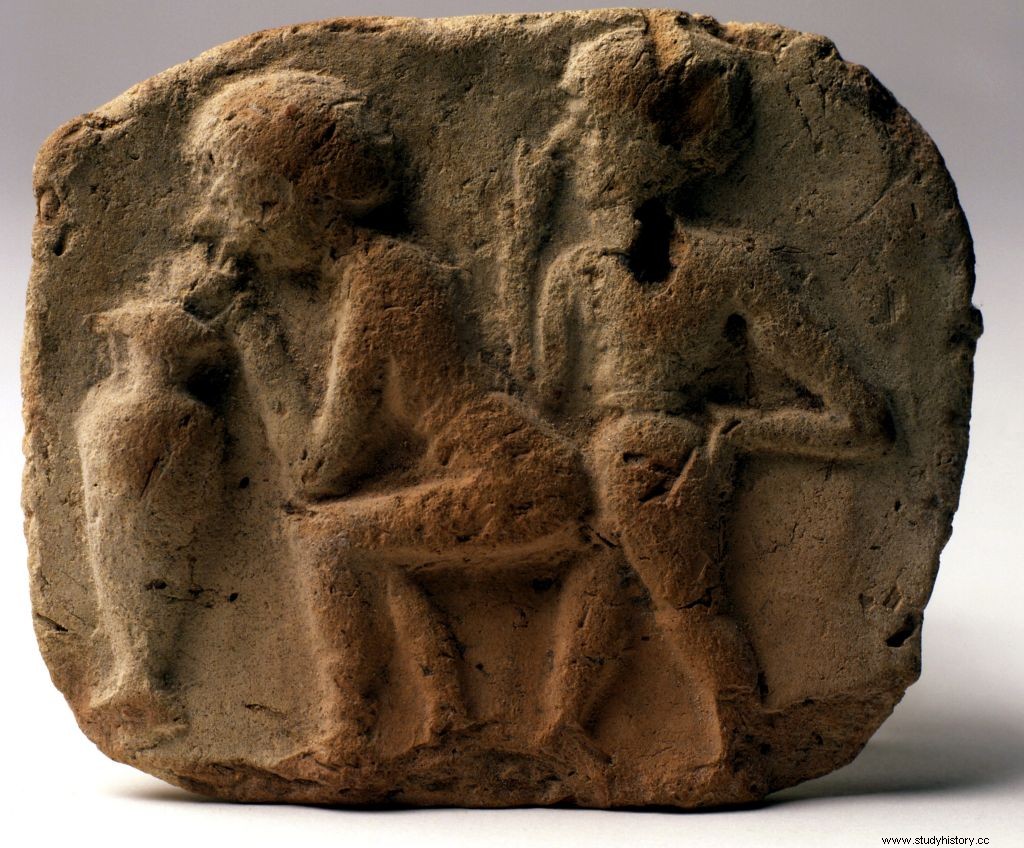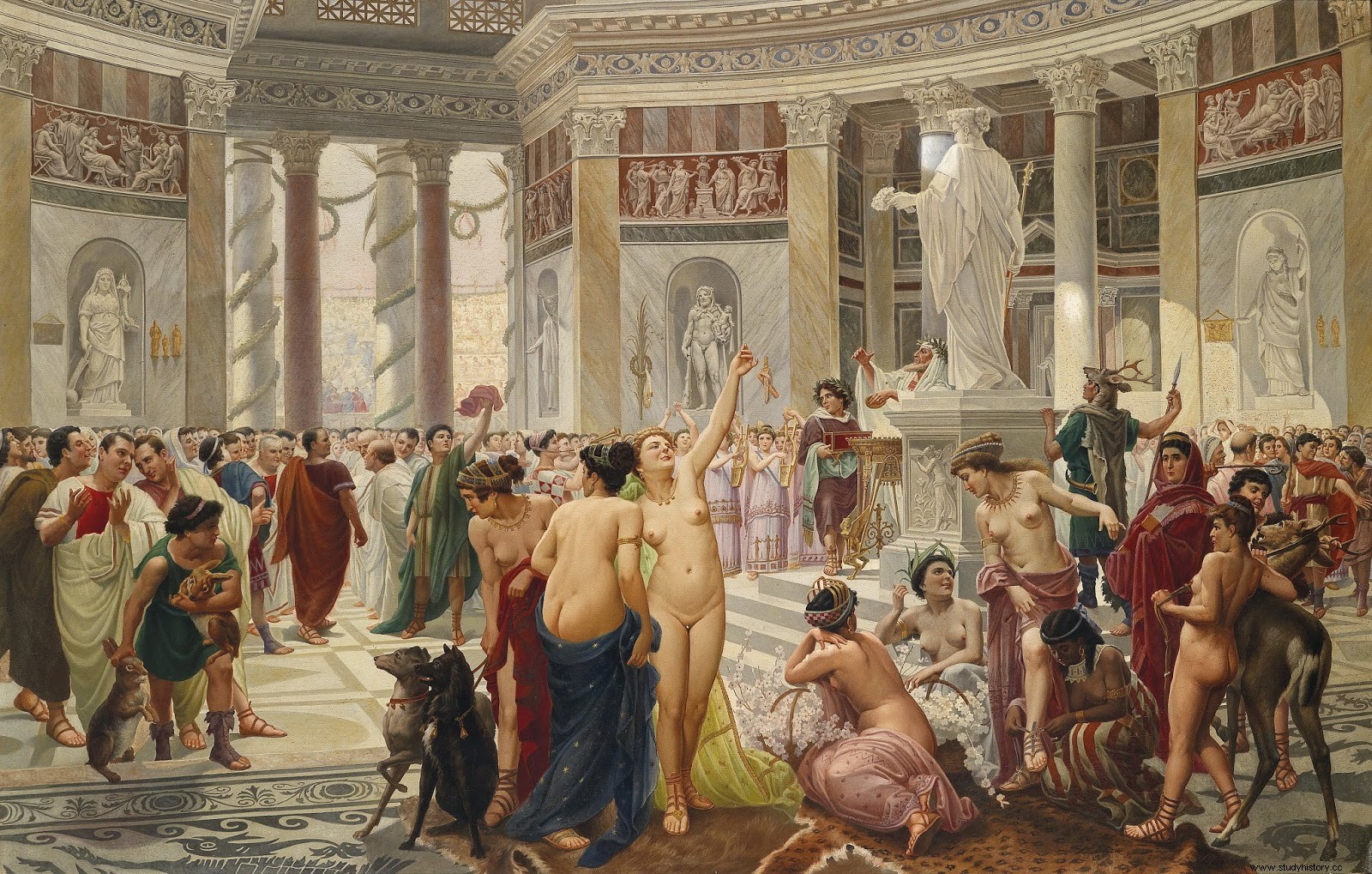Although it could well be that of a midwife, prostitution has always been euphemistically considered the oldest profession in the world. So, following tradition, we're going to tour Sumer and Rome to see what we find.
In Sumer, sex was lived and practiced with great disinhibition. The goddess who became the greatest of the Sumerian pantheon was Inanna (later Ishtar), goddess of love, sex and war, as well as protector of the crown... and prostitutes. How was it possible that a great goddess protected prostitutes? When we say the word "prostitution" today, images of sexual slavery, white slavery and abuse of women come to mind. A sordid world. Nothing to do with the world of the Sumerians, where prostitutes enjoyed prestige and social position. It was one more trade, with the addition of being considered extremely important, since the goddess Inanna was, in turn, the courtesan of the gods. We must keep in mind that the Sumerian gods ignored humans. The only divinity that had details with humanity was Inanna, who gave them her own sex. The work of the different prostitutes changed according to the times and the cities, so it is difficult to unravel the skein of names that has survived to this day. Generalizing a little we can distinguish the following types, in increasing order of importance:
- The lowest level were the simple prostitutes of the common people, who sought their clients in the ports and at the entrances of the cities. They were respected, because it was just another job. It had no negative connotation, except in the case of the "beer wives", who were slaves in the service of taverns with whom customers could lie even in front of everyone (we have already said that they were very uninhibited). The latter were despised, not because they were prostitutes, but because they were slaves.
- The Shamhatum they were graceful young women who engaged in high-level prostitution. What today we would call an "escort". They had social prestige, culture and collaborated on certain dates with the temples to serve the faithful for free in exchange for more social recognition.
- The Kulmashitum (sometimes that word was used to designate the working staff of the temple) they were sacred prostitute priestesses (hieródulas low level). Many times a humble widow or orphan was welcomed as a hierodula in a temple of Inanna. She thereby escaped from hunger and acquired social prestige. The bad thing is that she only accepted those who had no physical defects.
- The Kezertum they were hierodules who were distinguished from the others by having curly and long hair (some also think that they could have a kind of dreadlocks). It is believed that they acted on the street, possibly helping secular prostitutes and controlling small neighborhood altars.
- The Assinum they were men who dressed and put on makeup as women (transvestites). The Sumerians accepted homosexuality, although with a certain humor and ridicule —lesbianism was not discussed—.
- The Ishtaritum (women) and the Ishtarium (men) were the high level holy clergy. Obviously they only slept with rich people and people with a lot of power. Some Ishtaritum , like the Nin-Dingir, they did it with the king or the governor, since they were the goddess reincarnated in the world. By having sexual intercourse with the ruler, they transmitted her powers of command. Without that act of sex, the boss on duty could not be ratified in office.

In short, and although it may seem strange, it was a prostitution for religious reasons and out of compassion. The priestesses represented the only act of mercy that a member of the divine pantheon had towards his human servants. No husband was offended because his relative went off brown peaks with an Ishtarium , nor did they throw a vase at the head of the Manolo on duty for having been with a Kezertu . They considered it something normal and something to be proud of if the couple had been with someone of a high level. Obviously an amount was given to the hierodula for the upkeep of the temple. It is already known that all religions pass the brush, although in this case it had a bureaucratic character, since in Sumerian society taxes were paid almost even for breathing. If we also add that the temples were managed by the priestesses themselves, we obtain an exotic image of a world that today disgusts us and that, undoubtedly, it is difficult for us to understand. In any case, over time the Sumerian society became increasingly patriarchal and, in the time of the Babylonians, the priestesses no longer counted for anything, they did not manage or direct any business and it was the men who ran the show treating the priestesses as mere objects for sex. As a certain historian once said:
When men began to direct the sexuality of women, prostitution went from being a sacred act to becoming a vulgar and terrible act of sexual slavery
And if in Sumer prostitution was related to the divine, in Rome it was completely regulated. As Tacitus wrote, in order to practice prostitution they had to obtain the licentia stupri (In year 1 there were 32,000 prostitutes registered in Rome). To obtain this license, women were required to register with the mayor's office with their name, age, place of birth, and nom de guerre. And, as in Sumer, there were different classes and conditions:
- Delicatae :they were the luxury prostitutes that only the most powerful had access to. The ones that are now chosen with a catalog and a little apartment is put on them.
- Famosae :women who without any need, due to their social position, had sex for pure pleasure. The most significant case would be that of Valeria Messalina, wife of Emperor Claudius. How libidinous this woman would be who, taking advantage of the absence of her husband, organized a contest in the palace with the prostitutes of Rome based on seeing who could sleep with more men in a single day. The "school of prostitutes" accepted the challenge and sent Scylla, a true professional who had twenty-five coitus before giving up... Messalina continued through the night and, after declaring that she was still not satisfied after having lain with seventy men, she continued until dawn. The final count was two hundred.
- Lupae :those who exercised the trade in the brothels.
- Noctilucae :those who only worked at night.
- Copae :those who work in the caupona, a quick-drink shop and ready-made cold meals—usually wine, olives, bread, cheese, or pickles—that you could grab or go. There were no benches or tables, but an outside bar where customers for an ace could temper themselves with a glass of plucky wine and something to gnaw, throw some dice or "conquer" one of the drinks that hung around there.
- Fornicators :those who did it under the arches of bridges or buildings. The term fornix means "bow", from which comes to fornicate (have sex with a prostitute).
- Forariae :they worked on rural roads near Rome and their main clients were travellers.
- Bustuariae :near cemeteries… with a bit of mystery.
- Prostibulae :on the street without any control.

Cato the Elder already said it...
It's good that young men possessed by lust go to brothels instead of having to bother other men's wives
Prostitution in Rome also indirectly generated employment in the figure of the alipilarius , those in charge of plucking the pubic hair of the women of the wealthy classes and the prostitutes. In Rome they were not very supportive of pubic hair, and from adolescence they already began to shave. Our dear alipilarius he exercised his worthy profession in baths, brothels or at home directly in the domina's house. Among his work tools was the volsella (tweezers) and the philotrum (resin-based depilatory creams). In the words of the poet Marcial from Bilbilita…
Why do you shave, Ligea, your old cunt? Such delicacies are fine with girls […]. If you're ashamed, Ligea, stop pulling a dead lion's beard.
And although male prostitution was not so numerous, ladies and homosexuals did not have a hard time finding a young gigolo with whom to satisfy their needs. In fact, there were places for it, like the statio cunnilingus , where they offered themselves to practice oral sex. And of course, there were also several categories:
- Pathici :passive
- Ephebi :teenagers
- Fellators :fellators
- Spadons :castrated
- Amasii :for long-term relationships
